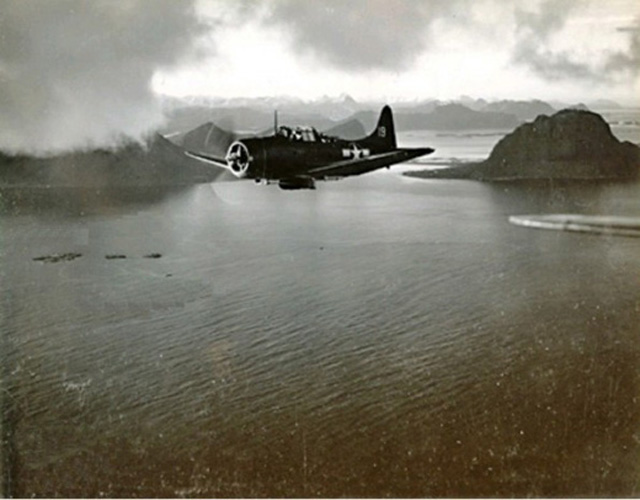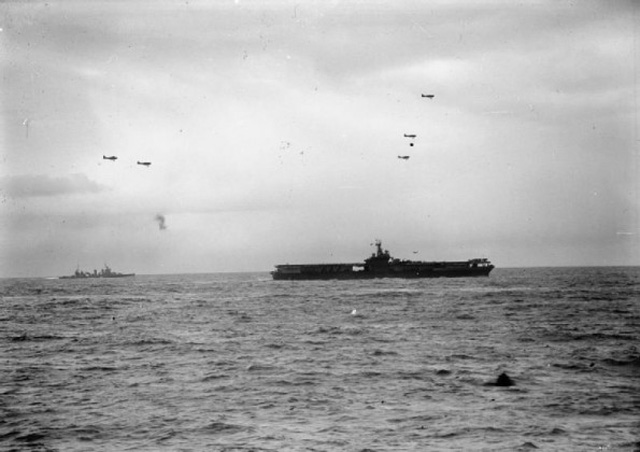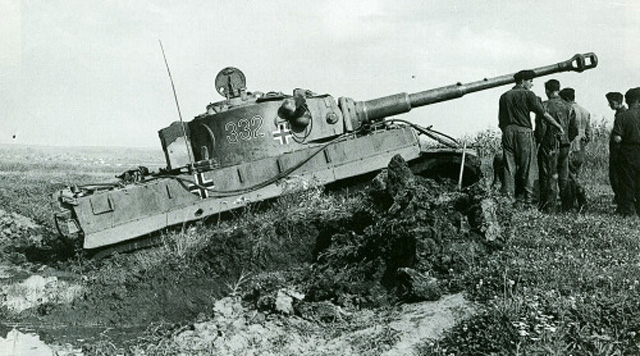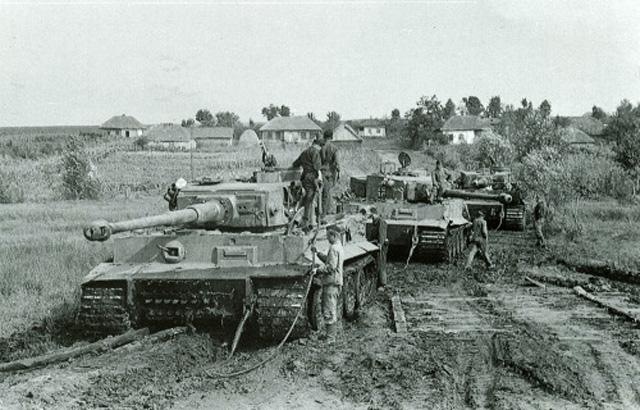Air Operations, Bismarcks
V Bomber Command B-25s attack villages, barges, and small craft in the Vitu Islands.
[Air Operations, CBI
CHINA- 17 Japanese bombers and 25 fighters attack the airfield at Kweilin. Although 14th Air Force fighters are unable to intercept, the Japanese bombs miss their targets.
Air Operations, Europe
Frankfurt is bombed in round-the-clock attacks. Among the casualties are 529 dead.
RAF BOMBER COMMANDEvening Ops:
- 406 aircraft are sent to Frankfurt. In this total are 162 Lancasters, 170 Halifaxes, 70 Stirlings and 4 Mosquitos. 3 American B-17s join in the raid.
- Clear weather and good Pathfinder marking produce the first serious blow on Frankfurt thus far in the war. There is extensive damage in the eastern part of the city and in the inland docks of the Main River. This is the last RAF night bombing raid in which American aircraft take part.
- 5 Halifaxes, 3 Lancasters and 2 Stirlings are lost as well as 1 of the American B-17s.
- 6 Lancasters carry out a diversionary raid on Ludwigshafen without lost but the marking and bombing are scattered.
- 12 Mosquitos are sent to the Knapsack power station, 1 Mosquito to Aachen, 5 Stirlings lay mines in the Gironde River and there are 8 OTU sorties. The Mosquito attacking Aachen carries out the first operational trial of the G-H blind bombing equipment, but the trial is not successful. There are no losses.
B-17F 'RUTHLESS' 547th BS 384th BG |
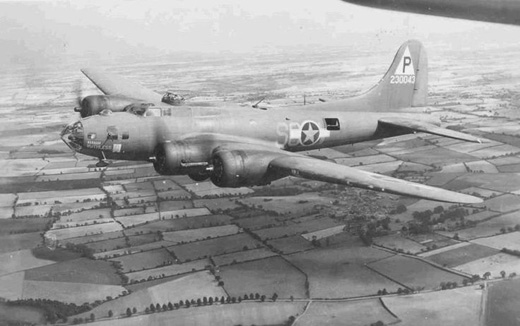 |
FRANCE:
- 3rd Bomb Division B-17s attack the St.-Dizier/Robinson Airdrome and a marshalling yard at Sarreguemines, both about 1140 hours.
- 25 3rd Medium Bomb Wing B-26s dispatched against several Luftwaffe airfields in France are recalled due to bad weather.
- When mission leaders fly 100 miles off the projected course, only 15 1st Bomb Division B-17s attack the day's primary target, an aircraft industry factory at Wiesbaden, with 45 tons of bombs. The 77 B-17s that are off course reach Frankfurt-am-Main, where they join a planned attack by 37 1st Bomb Division B-17s against aircraft-industry targets and the city itself. 304 tons of bombs are dropped between 1100 and 1111 hours.
- 3rd Bomb Division B-17s attack marshalling yards at Saarbrucken and an aircraft-industry factory at Saarlaudern between 1133 and 1139 hours.
- VIII Fighter Command mounts 223 P-47 escort sorties in support of the various bombing missions. 18 Luftwaffe fighters are downed along the bomber routes between 1030 and 1203 hours.
ITALY:
- XII Bomber Command B-17s attack bridges at Bolzano and marshalling yards at Pisa.
- XII Bomber Command B-25s and B-26s attack the Argos Airdrome, shipping at Bastia, a highway overpass at Mignano, and road defiles at Isernia and Terracina.
- NATAF aircraft attack numerous road, rail, and vehicles targets in and around the battle area.
Air Operations, Mediterranean
Combined with bombardments undertaken by the Royal Navy, 12th Air Force B-17s, B-24s, B-25s, and P-38s begin a week-long offensive against German air bases in Greece, Crete, and the Dodecanese Islands.
[Air Operations, Solomons
- 23 XIII Bomber Command B-24s attack the Kahili airfield on Bougainville.
- 4 AirSols F4Us and 4 P-39s are credited with destroying 16 barges in a sweep along Choiseulís west coast.
- 1 VMF-214 F4U downs 3 A6M Zeros over Moila Point at 1330 hours. A XIII Fighter Command staff officer and 4 347th Fighter Group P-38s down 4 Zeros over Kahili between 1330 and 1340 hours.
Arctic
In Operation LEADER German shipping off the Norwegian coast near Bodo is attacked by aircraft from the US carrier Ranger operating with the British Home Fleet. 4 freighters are sunk and 7 badly damaged at little cost. The battleships Duke of York and Anson are in support.
[
|
|
Battle of the Atlantic
- Planes (VC-9) from the US carrier Card (CVE-11) sink the 'U-tanker' U-460 and U-422 and damage U-264 near the Azores. A passing convoy escapes attack.
- The German submarine U-336 is sunk by US naval land-based aircrafte (VB-128) in the North Atlantic area.
- Ventura 'B' of VP-128 USN sights a U-boat on the surface which starts firing at the aircraft. The plane attacks through the flak and drops three depth charges along the starboard side under the stern, conning tower and bows. As the aircraft turned for a second attack U-279 could be seen settling in the water with smoke pouring from the conning tower. The crew abandons the submarine in four or five dinghies just before it sank.
|
|
|
|
Britain, Command
Adm Sir Dudley Pound resigns his post as First Sea Lord because of ill health. So determined to be a capable, 'hands-on' leader, he had taken on too great a work load and his decision-making, such as that concerning Convoy PQ-17, suffered accordingly. He dies on October 21. His position is taken by Adm Sir Andrew Cunningham after Adm Sir Bruce Fraser has refused the job.
[Corsica
The liberation of the island is completed when French Partisans, Moroccan Goums, American OSS agents and Italian forces enter Bastia.
[Italy
Eisenhower and Alexander forecast that Allied troops will be able to enter Rome by the end of the month. So, having decided to transfer GHQ form Algiers to Naples, Eisenhower now decides to wait so that he can establish himself in Rome.
[Mediterranean
German bombers attack Convoy UGS-18 damaging the US freighter Hiram S. Maxim (7176t) with a near-miss about 12 miles northwest of Cape Tenes, Algeria. The ship is abandoned by all but a skeleton crew of 7 and 6 Armed Guard sailors and then towed to Algiers for repairs. The freighters Leslie M. Shaw and Harry Lane rescues the remainder of those on board.
[New Guniea
The Australian 7th Div and 21st Bde advancing northwest up the Huon Peninsula manage to capture Dumpu as they extend their advance into the Ramu valley from the Markham Valley. Japanese forces are now confined along the northern coastline of the peninsula.
[Solomons
The Japanese complete the evacuation of Kolombangara. Despite the attention of American destroyers, 9,400 men of Gen Sasaki's garrison have been evacuated by Adm Ijuin's ships. A number of small boats have been lost, along with about 1,000 men.
[Wake Island
Ths isolated Japanese outpost of Wake Island comes under a heavy naval and aerial bombardment from the large US Navy Task Force 14 commanded by Rear-Adm Alfred E. Montgomery. B-24 Liberator bombers drop more than 320 tons of bombs. Some 61 Japanese aircraft are destroyed, comprising 30 on the ground and 31 in aerial combat. US forces lose 13 aircraft.
[
|
|
